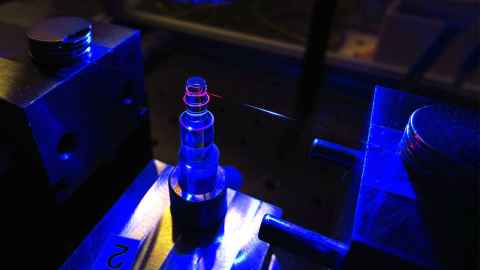Tiny rings of crystal used to change the colour of laser light
9 July 2019
A breakthrough could pave the way for low-cost and energy efficient sources of widely-tuneable laser light that may ultimately enable inexpensive handheld devices for medical diagnostics and environmental monitoring.

Publishing in the prestigious journal Nature Photonics, a team of researchers from the University of Auckland and the University of Otago discovered that ultrahigh-Q crystalline microresonators made of magnesium fluoride – tiny rings that can store extremely bright light – can be used to generate laser light whose frequency (colour) can be tuned.
The team showed that by launching a single low-power laser beam into a microresonator, two new beams with different and widely tuneable frequencies can be generated.
Devices that can generate tuneable laser light are very useful for spectroscopic applications such as detection and monitoring of hazardous gases in the environment. While commercially available devices exist, they tend to be expensive and bulky – roughly the size of a domestic microwave oven. In contrast, the novel microresonator system is cheap to fabricate, simple to operate, and tiny in size – approximately 20 times smaller than a New Zealand 10 cent coin.
The ability to generate tuneable laser light using compact devices could eventually lead to mobile devices that can detect changes in cells in the body as the first sign of disease such as cancer.
Dr Miro Erkintalo, one of the co-authors of the study, says that key to the research was the realisation that ultrahigh-Q microresonators made of magnesium fluoride could overcome limitations of previous implementations.
“Our model really takes advantage of the amazing properties of high-Q crystalline microresonators,” he said.
“Light intensities inside these tiny devices can be enormous, enabling strong light-matter interactions that underpin the generation of new frequencies.
“The fact that the frequencies of the generated beams can be so widely tuned is very exciting. It’s possible that the proof-of-concept we outline in our research could form the basis for commercial-scale, portable sensors, but that requires further research.”
The work was done by Associate Professor Stuart Murdoch, Associate Professor Stéphane Coen, Dr Miro Erkintalo, Dr Vincent Ng, PhD student Noel Sayson, MSc student Toby Bi, and MSc student Hoan Pham from the University of Auckland in collaboration with Dr Harald Schwefel and PhD student Luke Trainor from the University of Otago.
It was supported by a Marsden grant of the Royal Society of New Zealand Te Apārangi awarded to Associate Professor Stuart Murdoch in 2015 and by a Rutherford Discovery Fellowship awarded to Dr Miro Erkintalo in 2015.
The paper – ‘Octave-spanning tunable parametric oscillation in crystalline Kerr microresonators', is published in Nature Photonics
Media contact
Anne Beston | Media adviser
DDI 09 923 3258
Mob 021 970 089
Email a.beston@auckland.ac.nz